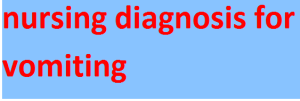nursing diagnosis for vomiting
nursing diagnosis for vomiting

Nausea is a bad feeling in the throat, epigastric area, or abdomen that may make you want to vomit but doesn’t always happen.
Infection, overeating, acid reflux, obstruction, and other gastrointestinal issues can all cause nausea. Anxiety disorders, medication side effects, pregnancy, and motion sickness can all cause nausea. Nausea can also be caused by disorders of the cardiovascular system, metabolic disorders, and the central nervous system.
Subjective nausea typically occurs in conjunction with anorexia or a lack of appetite. Dehydration and other complications, including severe electrolyte imbalances, loss of extracellular fluid volume, and circulatory failure, can occur when nausea and vomiting persist for an extended period of time.
The Nursing Process
It is essential to identify and treat the underlying cause of nausea, manage complications, and promote symptomatic relief when managing nausea.
To identify factors that are causing the problem, an in-depth evaluation must be carried out. In instances of chemotherapy, nurses can anticipate nausea and pre-medicate to prevent discomfort. Patients can also be taught about nonpharmacologic ways to prevent and treat nausea by nurses.
Nursing Care Plans Related to Nausea
Nausea Care Plan
Since nausea is typically a secondary cause of a primary diagnosis, it is a nursing-focused diagnosis.
Nursing Diagnosis: Nausea
Related to:
- Gastrointestinal problems
- Anxiety
- Noxious taste or smell
- Unpleasant sensory stimuli
- Exposure to toxins
- Alcohol intoxication
- Medication side effects
- Treatment or procedures like chemotherapy or radiation
- Pregnancy
- Motion sickness
- Increased intracranial pressure
- Pain
As evidenced by:
- Verbalization of nausea and urge to vomit
- Increased heart rate and respiration
- Cold, clammy skin
- Food aversion
- Increased swallowing
- Increased salivation
- Sour taste
- Gagging sensation
Expected Outcomes:
- The patient will verbalize relief from nausea
- The patient will be able to demonstrate strategies that prevent nausea
Nausea Assessment
1. Assess the possible causes and characteristics of nausea.
Nausea can be brought on by a physical, emotional, or medical issue. An effective treatment plan can be developed with the assistance of determining the cause of nausea.
2. Assess the patient’s hydration status.
Because nausea makes people averse to food and fluids, there is a risk of dehydration as a result of fluid loss, especially if vomiting is present.
Nausea Interventions
1. Provide the patient with routine oral care as needed.
Nausea is frequently accompanied by excessive salivation and vomiting. The unpleasant sensations and odors in the mouth will go away if regular oral hygiene practices are followed.
2. Eliminate offending smells from the room.
Strong odors can aggravate nausea.
3. Offer ginger ale and dry snacks.
Ginger has a calming effect on the stomach. Crackers and other bland foods prevent nausea from an empty stomach and are likely to be tolerated.
4. Encourage the patient to eat small frequent meals.
Patients who are nauseated may be unable to eat large meals and may be selective about the foods they can tolerate. Blood sugar levels can be stabilized, appetites can be satisfied, and nutrients can be provided throughout the day with small, frequent meals.
5. Encourage the patient to avoid spicy and greasy foods.
Foods that have been heavily seasoned can irritate the stomach and cause nausea.
6. Administer antiemetics as indicated.
Ondansetron and promethazine, two antiemetic medications, can be used to treat and prevent nausea.
7. Do not take medications on an empty stomach.
Inform patients that, unless contraindicated, they should take their medications with food if they are causing nausea.
Risk for Deficient Fluid Volume Care Plan
Because vomiting is frequently accompanied by nausea, patients are more likely to have low fluid volume. Electrolyte imbalances can occur during vomiting.
Nursing Diagnosis: Risk for Deficient Fluid Volume
Related to:
- Nausea and vomiting
- Difficulty meeting increased fluid volume requirement
- Inadequate knowledge of fluid needs
- Insufficient fluid intake
Click here for South African Nursing Colleges and Schools Application 2023-2024
RELATED LINKS
Nursing Online Application links
